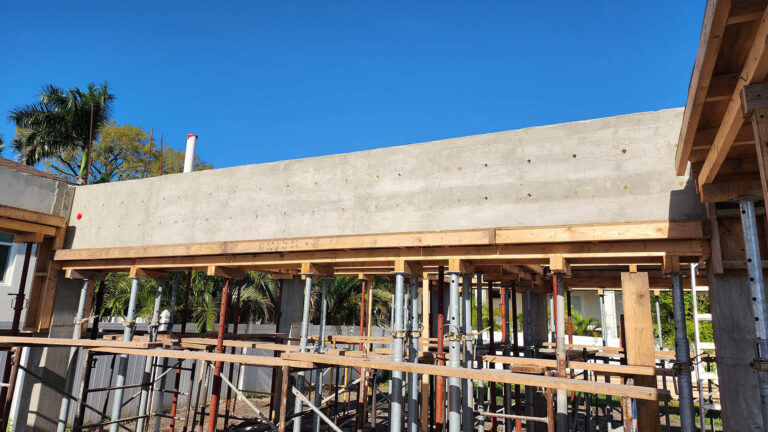Concrete buildings have been significant to the growth and spread of cities worldwide for a long time. The practices and techniques used to build concrete structures, everything from homes to commercial buildings, have been constantly improving and expanding. One common practice in construction is using cast-in-place concrete.
Cast-in-place concrete, or placement cast poured-in-place concrete, is a method of pouring concrete where the concrete part is already set. It is an ideal method for concrete blocks, foundations, and parts like beams, columns, walls, and roofs.
In this article, let us look at the definition of cast-in-place concrete, including where it came from, how it is made, and its benefits.
Defining Cast-in-Place Concrete
As mentioned earlier, cast-in-place concrete is one of the standard options for pouring concrete. It is mixed, poured, and allowed to cure on the job site using molds or formworks installed at different project stages.
Cast-in-place concrete is more flexible and adaptable, but the mix can be hard to control, especially during bad weather like rain or snow. Since you are at the stage of the project where your structural elements are exposed, it can be hard to control the quality of the concrete. It takes longer to build with cast-in-place concrete because it needs to be tested for strength and given time to cure.
A ready-mixed concrete truck is often used to bring the concrete to the job site before it hardens. A tube from the back of the car can drop the concrete where it needs to go or into a dumper or pump.
Why Cast-in-Place Concrete is Better
Cast-in-place concrete, also called site-cast or poured-in-place concrete, is poured directly onto a building site using forms. This differs from precast concrete, which is made away from the site and brought to the site to be put together. Compared to other methods, pouring concrete on site using formwork makes constructing substantial buildings last a long time. Because they are built to meet specific structural standards and designs from the start, the structures can handle bad weather and heavy loads as long as they are constructed correctly. It is the project manager’s responsibility to be able to forecast the schedule of when you will be pouring concrete on site and ensure that it goes according to plan since the concrete mix must be poured within a specific time frame.
Other methods, like precast concrete parts, need help keeping the structure together. They are made in workshops that keep a close eye on quality control, and then they must be moved to the building site.
The Standard Process For Cast-in-Place Concrete
In this section, let us describe how concrete is usually poured on the job site. While there is a standard process, always remember that the steps you take are dependent on the technical needs of your project, its size, scope, and the type of structure you are building.
Getting The Forms Ready
Formwork is a temporary building usually made of metal or wood used to size the concrete part. It holds the concrete in place, creating its shape while curing and hardening. It acts as the mold for your concrete, and its size or shape depends on what kind of structural element you need.
Placing Structural Reinforcements
Structural elements often need reinforcements, like structural rebars or mesh, to strengthen concrete and prolong its life. These reinforcements are placed inside the formwork before concrete is poured. It is usually essential to help the element resist tensile forces and keep it from breaking.
Pouring The Concrete
Cast-in-place concrete is put into the formwork after the reinforcement and formwork are set up. Most builders work with a ready-mix company that sends cement mixer trucks to the job site to mix the concrete. The maker will provide custom-made concrete to meet the contractor’s needs.
It is possible to pour ready-mixed concrete:
- Straight from trucks with ready-mix
- Putting in pump trucks
- Putting in a concrete slide
- By hand with wheelbarrows
Curing the Concrete
The concrete needs time to become rigid, and it is essential to ensure elements are in place for curing, like keeping the right temperature for the best hydration. With cast-in-place concrete, sensors and other monitoring tools can be used to maintain and monitor its progress down the form.
After the concrete is put into the molds, it will be checked with a concrete vibrator to ensure no holes are present. Honeycombing is less likely to happen near the sides of a slab when the concrete is vibrated. A screed can remove any extra concrete in the slab after the concrete has been vibrated. Getting rid of extra concrete is known as “striking off.” It is possible to float the concrete after it has been struck off, which makes the top layer of the concrete block smooth.
Removing the Formworks
The forms must be carefully removed to show the final part as soon as the concrete is strong enough. In this last step, the concrete building is ready to hold weight and do what it was built to do.
Types Of Cast-in-Place Structural Elements
In this section, let us look at the different structural elements where you can use cast-in-place concrete.
Slab-on-Grade
The concrete can be poured once the forms and supporting steel are set up for the slab-on-grade. There are many ways to finish concrete, but the broom and trowel finish are the most popular.
Every slab-on-grade foundation has a capillary break, a layer of crushed stone. This keeps water from the concrete slab’s bottom and lowers the chance of cracking.
Concrete Walls
Sand-filled concrete strips are used to build the ground-level walls. The footings for the concrete strips are formed in the same way that a slab-on-grade is.
In most cases, strengthening steel is placed inside the formwork in the middle of a concrete wall. These are set up to meet the steel reinforcing that sticks out of the concrete strip footings. If a floor, beam, or another wall is on top of the concrete wall, the reinforcement steel sticks out from the top to connect it with the next one.
Concrete Columns
Concrete columns are set on top of separate column footings, pile cap footings, or caissons. Dowels are put in the footings to match the vertical bars in the concrete beams. The concrete column reinforcement is removed from the placement site and lifted over the base dowels.
The steel also has reinforcement bars that stick out from the top to connect to the next-floor beam or can be bent at right angles to connect to the roof above.
Solid Slab in One Direction
This type of structural element is a solid block that only goes in one direction and runs across columns and walls that look like a single sheet of concrete. A one-way solid slab has bars that all run in the same direction. This usually depends on the consultant’s design.
The slab formwork can be installed after the walls and columns are built. The beams are part of a one-way solid slab formwork. In other words, the slab and beams are made simultaneously for each floor.
Joist Slab in One Direction (Ribbed Slab)
The span of a one-way solid slab needs to get wider as it goes up. The slab eventually gets so heavy that it can’t hold its weight. That is why the ribbed slab was made, another name for the one-way concrete joist slab. The ribbed slab comprises joists, distribution ribs, and beams spaced out at regular intervals.
Two-Way Flat Plate and Slab
Two-way slabs are often cheaper than one-way slabs when arranging the concrete blocks in a square shape. Still, two-way slabs are used sparingly. Industries with big loads usually use them in buildings with those loads. When there is a lot of weight on the building, many beams can be run in both directions to make either the two-way flat slab or the two-way flat plate.
The Two-Way Waffle Slab
The one-way concrete joist system is similar to the waffle slab, also called a two-way concrete slab system. The most crucial difference is that joists run in two different ways that are not parallel. Because it removes almost all the concrete that isn’t being used, the two-way waffle slab can span much farther than the two-way flat slab. This is because all of the concrete is used for structural reasons.
How To Know If Using Cast-in-Place Concrete is Right For You
It is really up to the project.
Most of the time, cast-in-place forms must be built according to plan for more complicated jobs. Because it is more efficient and better controlled, precast is generally better for box-shaped, more significant buildings. Premade pieces should work well because they don’t need to be a particular shape. But each job is unique. Even if no odd forms are required, precast may not be the best choice.
Here are some key considerations to know if your project is an excellent candidate to use cast-in-place concrete.
Weather
For the cast-in-place method to work, the weather must be reasonable, and the temperature must be between 68 and 72 degrees. Humidity is another weather factor that can affect concrete buildings. The cement can lose too much water when the air is too dry.
Concrete Type
When building with some types of specialized concrete, it needs to be made in place, while other types are precast. Concrete comes in many different types, and the suitable building method depends significantly on which one is used.
Design and Specifications
Cast-in-place is usually used when the building plans are more complicated or have complex shapes. Precast construction could help build things that are square or rectangular.
Schedule
It is essential to know that building with cast-in-place takes longer. Precast may be the best choice if the project needs to be done quickly.
Budget
Consider the differences between the higher cost of precast forms and the lower cost of work for cast-in-place.

